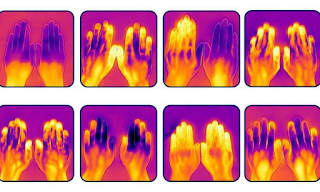Cambridge biological anthropologists have shown that muscle mass is able to predict the rate of heat loss from the hands during severe cold exposure, while body mass, stature and fat mass do not. According to Stephanie Payne, lead author Hands have a large surface area-to-volume ratio, which can be a challenge to maintaining thermal balance in cold conditions.
We wanted to study the influence of body size and body composition on heat loss and rewarming in the hands to determine whether they affect hand temperature and dexterity in cold conditions. These results are important for understanding thermoregulation (the body’s ability to regulate its temperature).
Volunteers from around Cambridge, including University students and local residents, took part in the study. After having their vital statistics taken and body composition analysed to measure the amount of fat and muscle, each volunteer plunged their hands into ice cold water for three minutes. The rate at which volunteers’ hands heated up again was measured and recorded using a thermal imaging camera.
Volunteers were of European origin and aged between 18 and 50. Many populations across the globe have developed vasoregulatory adaptations to deal with severe cold. Some populations lose blood flow to the hands very quickly to make sure they retain their body heat internally, whilst others, for example the Inuit, have periodic pulses of blood to the hands to combat frostbite.
Being aware of the effects of body composition on how cold your hands get is crucial. For example, women and children are less likely to have a high muscle mass so cold-weather gear, such as gloves, should be produced and marketed with that in mind.
haleplushearty.blogspot.com


